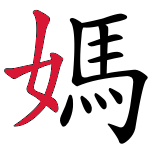Radical (Chinese character) facts for kids
A Chinese radical is a special part of a Chinese character. Think of it as a building block for these characters. Radicals help you find characters in a dictionary. They also often give you clues about what a character means.
The word "radical" (部首, bùshǒu) has two main meanings. First, it's a part of a character that hints at its meaning. Second, it's the "section header" in a dictionary. This is where you look up a character.
Contents
What Are Chinese Radicals?
Radicals are usually simpler characters themselves. Or, they are slightly different versions of simple characters. They combine with other parts to create more complex Chinese characters. There are thousands of Chinese characters, but most of them are made from just 214 main radicals.
How Radicals Help Us Understand Characters
Radicals can give you hints about a character's meaning. For example, the character 明 (míng) means "bright" or "tomorrow". It's made of two radicals:
- 日 (rì) means "sun" or "day".
- 月 (yuè) means "moon" or "month".
When you put the sun and moon together, it makes sense that the character means "bright"!
Sometimes, a radical might not be a full character on its own. For instance, the character 休 (xiū) means "to stop" or "to rest". It uses two radicals:
- 亻 (a changed form of 人 rén, meaning "person"). This form never stands alone.
- 木 (mù, meaning "wood" or "tree").
So, a person resting by a tree makes sense!
Radicals and Sound Clues
Radicals can also give clues about how a character sounds. Look at the character 媽 (mā), which means "mother".
- The left part, 女 (nǚ), means "woman". This is the part that tells you about the meaning.
- The right part, 馬 (mǎ), means "horse". This part helps with the sound. Even though "mother" has nothing to do with a horse, 馬 helps you remember the "ma" sound.
Sometimes, a radical is just used to help you find the character in a dictionary. It might not give a meaning or sound hint. For example, in the character 亞 (yà), the radical 二 (èr, "two") is just for dictionary sorting.
Radicals in Dictionaries
Chinese character parts are the building blocks for characters in many languages. This includes Chinese (Hanzi), Japanese (Kanji), Korean (Hanja), and Vietnamese (Chữ nôm and Chữ nho).
The Kangxi dictionary, created in 1716, used a list of 214 radicals to organize its characters. This list of 214 radicals is still very important today. It helps people find and learn characters in dictionaries for Chinese, Japanese, and Korean.
See also
 In Spanish: Radical (sinograma) para niños
In Spanish: Radical (sinograma) para niños


